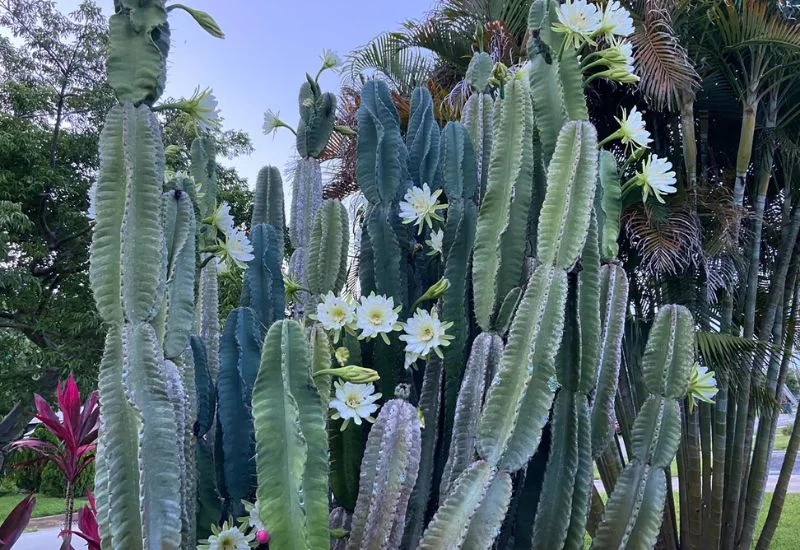In this post, I’m going to give you in-depth information about Peruvian Apple Cactus.
This is a cactus whose flower blooms only for a night; Sounds interesting!
Besides this, here are a couple of other mind-blowing things about it:
- Basic information
- Care tips
- Easy way of propagation
- Related problems and their effective solutions
- Buying guide
An Overview of Peruvian Apple Cactus
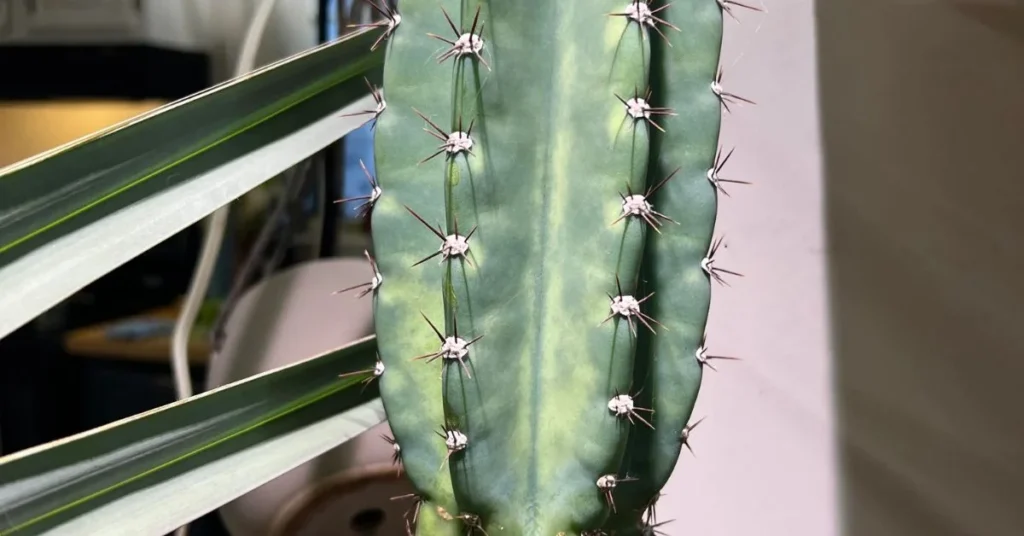
| Common Name | Hedge cactus, Night-Blooming Cereus Cactus, Peruvian Tree Cactus, Screw Cactus Plant |
| Botanical Name | Cereus repandus |
| Family | Cactaceae |
| Plant Type | Perennial cactus |
| Fruit | Yes |
| Mature Size | 15 to 30 feet |
| Sun Exposure | Direct sunlight |
| Soil Type | Well drained soil |
| Soil pH | 6 to 7 |
| Native Area | South America specifically Argentina, Uruguay, and Brazil |
| Toxic | No |
| Growth | Slow |
Apple cactus is large, thorny, and column-like in appearance. It produces edible apple-like fruits with a wonderful taste.
The scientific name of this cactus is Cereus repandus. This plant has other common names, such as Night-Blooming Cereus Cactus and apple Cactus.
Cereus peruvianus is a native of South America. The main growth habitats of Peruvian cactus are Argentina, Brazil, and Uruguay. It’s a slow-growing plant that can have a height of fifteen to thirty inches and a width of six to eight inches.
Flowers and Fruits
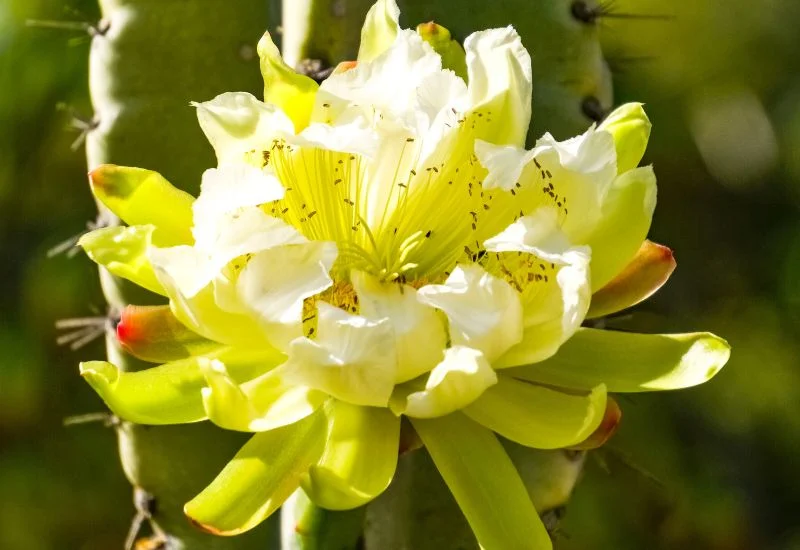
The stem of the apple cactus is greyish-green to bluish. peruvian apple cactus blooms in late spring and early fall with showy, fragrant white flowers. These nocturnal flowers are edible but blossom only for one night.
Peruvian cactus produces thornless, delicious fruits known as Peruvian apples or pitaya. The fruit comes in red, violet, and yellow in color from the outside. The interior of the fruit has a white color and crunchy seeds. There are high levels of beta-carotene, vitamin C, dietary fiber, and precursor of vitamin A.
Toxicity
The Peruvian apple cactus is not poisonous to humans and animals. This plant produces edible fruits that are rich in nutrients. The cactus’s spines are sharp, so you need to watch out for that.
Benefits

Here is the list of growing Peruvian apple cactus:
Ornamental Appeal
This plant is famous for its unique texture. The length and sculpture quality make it a perfect indoor and outdoor plant.
Low Maintenance
The cactus is drought-tolerant and does not need daily watering. This plant is the perfect choice for people who have busy schedules.
Night Blooming Flowers
This plant produces beautiful white flowers. The flowers are fragrant and bloom at night. The flowers attract nocturnal pollinators like bats and moths.
Edible Fruits
This plant produces food that can be eaten fresh. The fruit is rich in nutrients and can be used as a jam.
Air Purifying
The cactus plant helps improve the environment. Like other plants, it absorbs carbon dioxide at night and releases oxygen in the morning.
Therapeutic Uses
This plant has anti-inflammatory and anti-antioxidant properties. These properties are good for your skin and health.
Continuous Learning and Engagement
By taking care of the Peruvian cactus, you always learn new things. It’s not about placing it in the corner. You learn new behaviors and the needs of the plant. you can share your experience on different online forums.
Propagation
Step 1: Prepare Your Cutting
- Tools: shears and scissors
- Supplies: A healthy plant
Take a healthy stem at least 4 to 5 inches long. Cut at 45 degrees. Make sure to use only sterilized equipment or your plant can get infected.
Step 2: Allow Cut to Callous
- Supplies: A dry, safe place
Leave the cutting for 1 or 2 weeks to callus over.
Step 3: Start the Water Propagation
- Tools: Ceramic or terracotta-made pot.
- Supplies: Water and soil
Step 4: Rooting Hormone
After callous formation, dip the cutting in the rooting hormone. This step is not necessary, but it will boost the plant’s growth.
Step 5: Planting in Soil
- Tools: ceramic or terracotta pot is recommended.
- Supplies: well-drained soil
Now place your cutting into the potting mix. Do not bury the stem deep in the soil. A few inches deep is fine. The stem needs sunlight to grow. Water the pot and place it in a warm place.
Propagation Mistakes to Avoid
Here are the common mistakes that most people do:
- Choosing wrong soil
- Cutting wrong
- Overwatering
- Not allowing cutting to callus
- Planting too deep
- Ignoring preferred temperature
- Neglecting to sterilize equipment
Patience and Observational Care
The propagation needs time and patience. Once you place the stem, monitor your plant. Make sure the temperature and sunlight are as per the plant’s needs.
Repotting
Peruvian apple cactus needs repotting every 2 to 3 years. The best time is when the roots outgrow the drainage hole. Here is a simple guide on how to report your cactus:
- Take a new pot 3 to 4 inches bigger than the previous one
- Make sure the pot has a drainage hole
- Take out your plant from the pot
- Shake it to dust off extra soil
- If the roots are tangled, gently untangle them with your hands
- Place your plant into the pot and hold it still
- Add the soil into the pot and water the soil to settle
- Make sure the drainage hole of the pot is working
- Place the pot in a location where needed sunlight is available
Peruvian Apple Cactus Care
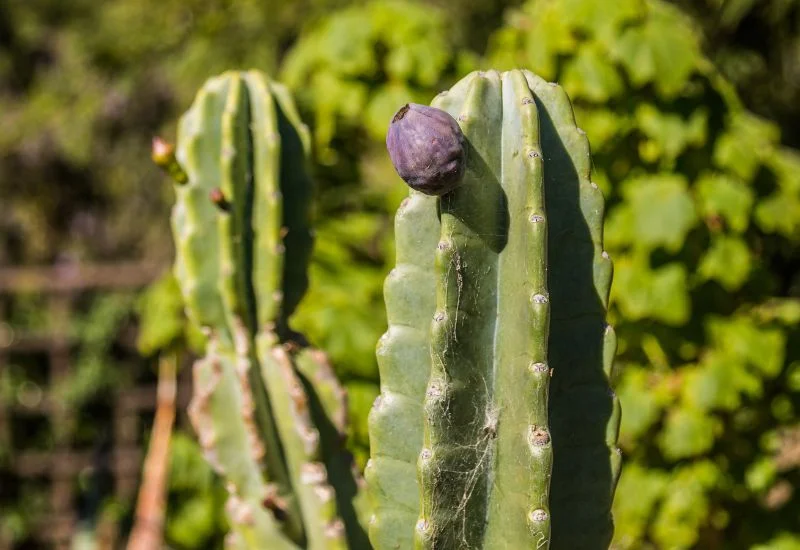
Here is the step-by-step guide on how to take care of your Peruvian apple cactus:
Step 1: Pot Selection
Try to find a pot that is wide and tall. Large pots lead to the issue of drainage, and you have to use too much soil. The shallow pot becomes root-bound too fast.
Step 2: Soil Requirements
As the cactus are plants of deserts, you will need to maintain special soil conditions. To make soil, mix potting soil, perlite, coarse sand, and peat in equal quantities. Make sure its pH is between 6.0 and 7.0.
Step 3: Placement
This plant needs direct sunlight for at least 6 hours of the day. Place the cactus in a location where temperature and humidity are as per the need. Make sure to maintain the needed air circulation.
Step 4: Lighting Conditions
Six to eight hours of full sunlight is ideal for an Apple cactus. However, if it is in a growing stage, then place it in bright, indirect light.
If this cactus is a part of your room decorations, then place it near the window. Warm and sunny conditions ensure the healthy growth of your cactus. Low light can reduce stems’ vibrancy, and direct sunlight can scorch them.
Step 5: Watering
Its succulent nature helps the cactus withstand long periods of drought. Water the cactus once every three weeks during spring and summer. During the dormant period, water the cactus once a month. Ensure the soil dries out between waterings to avoid root rot.
Step 6: Temperature and Humidity
Apple cactus can bear high temperatures but avoid both the cold and hot extremes. The preferred temperature is 18° to 24°C, whereas the humidity should be 40-60%. More humidity can lead to fungal diseases.
Step 7: Fertilization
You don’t need to fertilize this cactus more often. Feeding the cactus once every 2 months is more than enough. Overfertilization can prove harmful to your cactus.
Moreover, if you add a little fertilizer during making the soil mixture, it will speed up the growth.
The balanced fertilizer for a Peruvian cactus is an NPK (Nitrogen, Phosphorus, Potassium) fertilizer with a 5-10-5 ratio.
Step 8: Pruning
The cactus apple plant can grow up to 20 feet. To control its growth and size, you can prune it. The best time for pruning is at the start of spring because, at that time, the cactus is in its active growth.
Avoid pruning in the winter, as it’s downtime for the plant and can lead to stunned regrowth. Use sharp and clean pruning objects, and make sure not to cut too much.
Step 9: Seasons
Winter
In winter the cactus needs water once a month. Apply the fertilizer after watering the cactus once every two months.
Summer
In summer, this plant needs water every 2 to 3 weeks. Do not apply the fertilizer in winter or fall.
Regular Review and Adjustment
To maintain the health, you need to monitor the plant regularly. Ensure the needs of the soil, light, temperature, and watering are as needed. Make changes in the care schedule as the season changes.
Common Problems
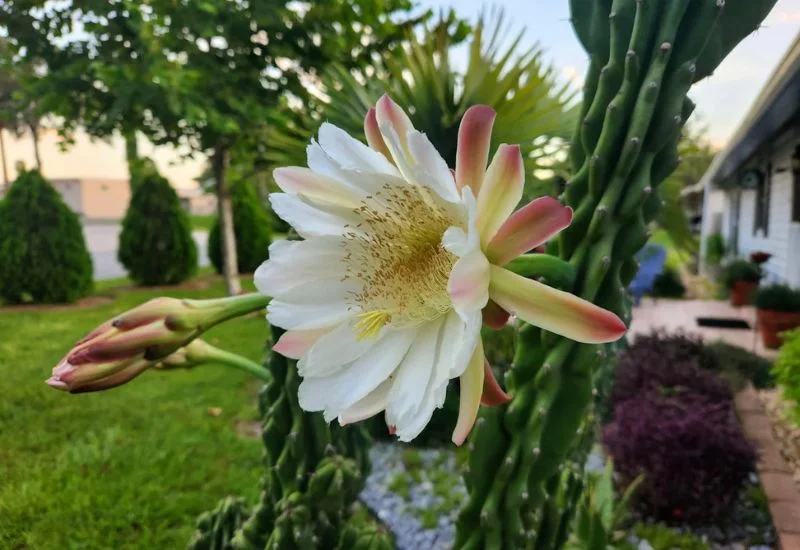
Here is the list of common problems in the Peruvian apple cactus plant:
Pests
The common insects that attack your plant include nematodes, spider mites, and aphids. Change the infected potting mix, use insecticide soaps, and quarantine the plants. Ensure that these treatments do not damage your plant.
Fungal Diseases
Sometimes, yellow, brown, or black spots appear on the stems. This is the invasion of the fungus on your cactus. To prevent it, you need to provide proper ventilation and organic fertilizers. You can also use small amounts of fungicides that will protect your cactus from molds and fungi.
Overwatering
Overwatering and poor drainage cause root rot. Moreover, the stems can also turn yellow and brown due to extra moisture in the water. Therefore, you must maintain a proper gap between waterings.
Nutrient Deficiency
This plant does not need to be fertilized often. However, total negligence can cause nutrient deficiency. It can cause discoloration and slow growth of plants.
Sunburn
Exposure to direct sunlight can lead to sunburn. The symptom can be white or yellow patches on the stems. Place your plant in indirect sunlight or under the shade.
Proactive Health Monitoring
For the continued health of your plant, inspect it. Look for any pest infection. Change the caring schedule to meet the needs of the Peruvian cactus. Adjust your maintenance as per the plant’s response.
Varieties and Similar Plants
Here is the list of varieties and similar plants of Peruvian apple cactus:
Varieties
- Cereus repandus ‘Monstrosus’
- Cereus repandus ‘Spiralis’
Similar plants
- Echinopsis peruviana
- Pilosocereus pachycladus
- Cereus hildmannianus
Peruvian Apple Cactus Vs. San Pedro

Here is a comparison between the Peruvian apple cactus and the San Pedro cactus. Both plants share some similarities, but they also have differences. The comparison is well-defined and that is easy to understand in the table.
Differences
Here are the 8 key differences.
| Differences | Peruvian Apple Cactus | San Pedro Cactus |
| Flowers | Large white flowers bloom at night | White flowers with white and green spathe |
| Stems | Grayish-blue to green | The color of the stems is pale green to blue when young as it gets matures the color turns dark green |
| Growth pattern | The color of the stems is pale green to blue when young as it gets matures, the color turns dark green | The height of the plant can up to 10 to 30 feet in length and 3 to 6 feet in width |
| Temperature | 70 °F to 90 °F | 55 °F to 75 °F |
| Price | $15 to $75 | $15 to $150 |
| Hardiness zone | 9-11 | 8b-10 |
| Native area | Argentina, Brazil, and Uruguay | South America |
Similarities
Here are 11 key similarities.
| Similarities | Peruvian Apple Cactus | San Pedro Cactus |
| Watering needs | When the top inch of soil starts to dry | Needs water when the top inch of soil starts to dry. |
| Soil | Well-drained cactus soil | Well-drained, moist soil for cactus |
| Placement | Direct sunlight | Direct sunlight |
| Fruit | Yes | Yes |
| Roots | The roots spread instead of going deep. | The roots spread widely, which is good for absorbing moisture from the soil. |
| Toxicity | No | No |
| Disease resistance | Good | Good |
| Fertilizer | The roots of spread widely which is good for absorbing moisture from the soil. | It needs fertilizer to boost its growth every once a month. |
| Bloom time | Spring, summer | Spring, summer |
| Availability | Common | Common |
| Growth rate | Slow | Slow |
Buying Guide
Considerations Before Buying
Before buying, inspect the plant. There should not be discoloration or damaged stems. Check the environment of the place where you live. Before buying, make sure the environment matches the Peruvian apple cactus needs.
Price Range
The price range of the Peruvian apple cactus can vary from $24 to $275. Depending on the size of the cactus.
Where to Buy
The Peruvian apple cactus is a common problem. The availability of plants is good. You can check stores near you first. Yet, there are different online stores where you can order the cactus. This plant is also available on Amazon and Etsy.
Here you have it
A comprehensive guide about the Peruvian apple cactus.
Have you made up your mind to buy it?
Which thing do you like the most about this cactus?
Let me know your opinions about this cactus in the comments section!
